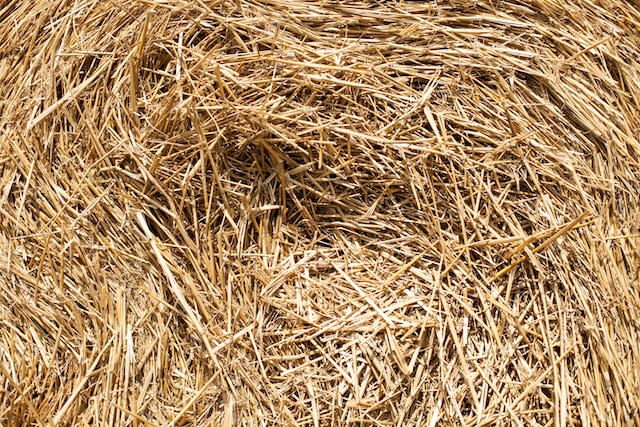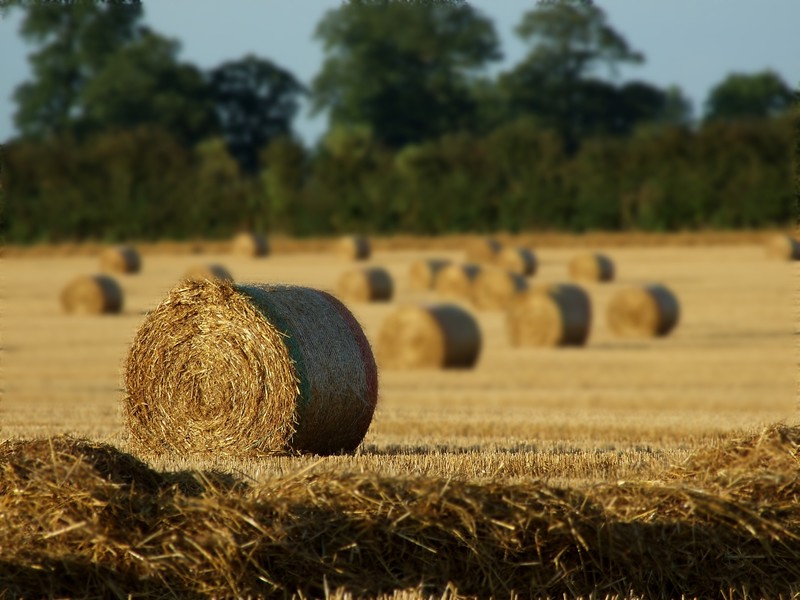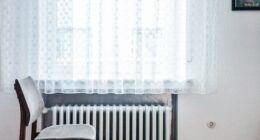Straw is primarily used as animal bedding or in gardening, while hay is mainly used as animal feed. Hay contains more nutrients than straw and has a higher price tag to match. If you’re looking for affordable bedding material for your animals or mulching in your garden, then straw is the way to go. However, if you need nutritious feed for livestock, then hay should be your choice.
What is straw?
(Photo by Dan Cristian Pădureț on Unsplash )

Straw is an agricultural byproduct that is left over after the harvest of cereal crops such as wheat, barley, and oats. It is made up of the stems and leaves of these plants which are dried out and then baled for storage or transport. The most common type of straw used in farming practices is wheat straw.
Straw has many uses ranging from animal feed to bedding material to building insulation. Farmers often use it as a cheap source of roughage for their livestock since it provides them with fiber without adding too many calories. Another popular use for straw is as bedding material for animals such as horses or chickens because it helps absorb moisture and keeps them warm during cold weather.
Straw can also be used in construction applications such as insulation or even in making paper products. In fact, some artists even use straw to create sculptures due to its malleability when wet.
While straw may not have much nutritional value, its versatility makes it a valuable resource in agriculture and beyond.
What is hey?
(Photo By Jonathan Stonehouse on Flickr)

Hay is a type of forage that is commonly used as animal feed. It’s made up of dried grasses, legumes or other plants that have been cut and then left to dry in the sun. Once it has reached the desired moisture level, it is baled up into large round or rectangular bales for storage.
There are different types of hay available depending on the plant species used to make them. Timothy hay, alfalfa hay and clover hay are some common varieties you might come across.
Hay can be an important source of nutrition for animals like horses, cows and sheep which require high-fiber diets to maintain good digestive health. However, not all hay is created equal – its nutritional value can vary depending on factors such as maturity at harvest time and how it was stored after being baled.
In addition to being used as animal feed, hay can also serve other purposes such as erosion control or bedding material for livestock. The uses depend on their quality; higher-quality hays are perfect for feeding while lower-quality ones may only be suitable for bedding and other non-consumable applications.
Straw Vs. Hay – Key differences
When it comes to straw and hay, there are some key differences that set them apart. The first difference is in their composition. Straw is made from the stems of grain plants such as wheat, barley or oats after they have been harvested. On the other hand, hay can be made from a variety of grasses like timothy, clover and alfalfa which are cut before they seed.
Another difference between the two lies in their usage. While straw is mostly used for animal bedding, insulation and mulching gardens, hay primarily serves as food for livestock during winter months when fresh pasture isn’t available.
The third difference between them is in how they look. Straws tend to be lighter than hays with a golden color while hays come in different colors depending on where it’s grown and what type of plant was used to make it.
Because straw contains fewer nutrients compared to hay which has higher protein content due to its leaves being included during harvesting – feeding animals with straw alone could cause malnutrition over time unlike Hay which provides sufficient nutrition.
Understanding these key differences can help you choose between using either material effectively based on your needs whether it’s for gardening or farming purposes.
What is the difference between a bale of straw and a bale of hay?
A bale of straw and a bale of hay may look similar, but there are key differences between the two. Firstly, straw is made from dried stems of cereal plants such as wheat or barley after the grains have been harvested. On the other hand, hay is made from various types of grasses and legumes that are cut when they are still green and then left to dry.
Another difference between the two is their uses. Straw is commonly used for animal bedding, as it provides insulation and can absorb moisture well. It can also be used as a mulch in gardens to prevent weed growth and retain soil moisture. Hay, on the other hand, is primarily used for animal feed.
One way to tell the difference between a bale of straw and a bale of hay is by their color – straw typically has a golden hue while hay tends to be greener in color. Additionally, if you were to handle both types of bales, you would notice that hay feels softer due to its higher leaf content.
Although they may seem similar at first glance, knowing the differences between straw and hay can help you better understand how each one can be utilized effectively in different situations.
How are straw and hay used?
Straw and hay are both versatile materials that have been used by humans for centuries. Straw is most commonly used as a bedding material for livestock or as a building material, while hay is primarily used as animal feed.
Straw has the ability to absorb moisture and provide insulation, making it an ideal choice for animal bedding. It’s also lightweight and easy to handle, which makes it an excellent option for use in construction projects such as thatching roofs or covering garden beds.
Hay, on the other hand, contains valuable nutrients that animals need in their diets. It’s typically made from grasses like alfalfa or timothy and can be fed to livestock like cows, horses, sheep or goats.
In addition to being used as animal feed, hay can also be utilized in landscaping projects such as mulching flower beds or adding organic matter to soil. It’s important to note though that feeding straw instead of hay may lead to digestive issues with your animals due its lower nutritional value.
What are the benefits of straw and hay?
Straw and hay may seem like simple materials with limited uses, but they actually have a variety of benefits. Here are some advantages of using straw and hay:
Insulation: Straw is an excellent insulator, making it ideal for use in construction projects or as bedding for animals. It can help keep buildings warm in the winter and cool in the summer.
Weed control: When used as mulch, straw can suppress weed growth by blocking sunlight from reaching the soil surface.
Soil improvement: As straw breaks down over time, it adds organic matter to the soil, which can improve its structure and fertility.
Animal feed: Hay is a common type of animal feed that provides both nutrition and roughage for livestock such as horses, cows, sheep, goats, etc.
Fuel source: Both straw and hay can be used as fuel sources when burned properly.
Cost-effective: Using straw or hay instead of other building materials or types of animal feed can often be more cost-effective since these materials are widely available at low prices compared to alternatives.
How do you tell the difference between straw and hay?
When it comes to distinguishing straw and hay, there are some key characteristics that you can look out for. Firstly, the texture of these two materials is quite different. Straw tends to be much coarser than hay with a rougher feel due to its hollow stems. In contrast, hay is softer and more flexible as it is made up of leaves and seed heads.
Another way to differentiate between straw and hey is by their color. Typically, straw has a yellow or beige hue whereas hay can range from greenish-yellow to brown depending on when it was harvested.
In addition, the uses of these two materials also differ greatly which can help in telling them apart. Straw is commonly used for animal bedding or as packing material while hay serves primarily as animal feed.
It’s important to note that sometimes producers will sell both straw and hey together in bales which can make it challenging to distinguish them apart visually. In cases like this, one could ask the seller directly about what they’re buying if they’re unsure.
By looking at texture, color, usage(s) or asking sellers directly for clarification; anyone could quickly identify whether they’re dealing with straw or hey without any confusion!
Is straw better than hay for bedding?
When it comes to animal bedding, both straw and hay can be used. However, the question arises: is straw better than hay for bedding? The answer depends on a few factors.
Straw is often preferred over hay as it is less likely to contain seeds which can lead to unwanted growth in the animal’s living space. Straw also tends to be cheaper than hay and provides good insulation during colder months.
However, if your animals are prone to allergies or respiratory issues, then hay may be a better option as it has less dust compared to straw. Additionally, some animals prefer the taste of hay over straw making them more likely to consume their bedding.
It’s important to consider the specific needs of your animals when choosing between straw and hay for bedding. Both options have their benefits and drawbacks so it ultimately comes down to what works best for you and your furry friends.
featured Image By – Vanessa Schulze on Unsplash







